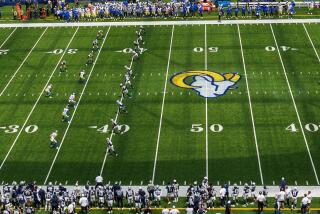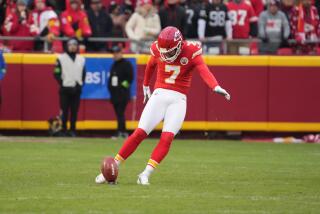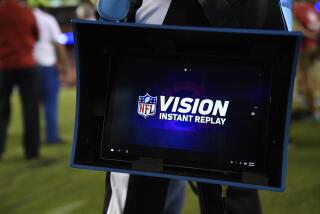This New Rule Has Referees Seeing Red
The most important video to be released this year will not be some syrupy nonsense from Disney or some equally inane Hollywood drivel-a-thon.
It will be an instructional video that FIFA, world soccer’s governing body, will distribute in the next few weeks to players and coaches worldwide, especially those heading for France and the ’98 World Cup.
The subject matter?
An examination of what constitutes an illegal tackle from behind, which, under a newly modified rule, must be punished by immediate expulsion from the game.
Soccer has gotten along pretty well for more than a century without such meddling, but the suits in the boardroom these days appear unable to keep their distance from the track suits on the field.
As a result, there is every reason to expect a flood of red cards at this summer’s World Cup, with nervous referees reaching for their pocket at the slightest sign of an aggressive tackle.
And just imagine what that will do. Brazil’s Dunga stretches out a leg, successfully pushes the ball away but in the process brings Norway’s Ole Gunnar Solskjaer crashing down in a heap.
Out comes the red card. Off goes Dunga, and Brazil has to play the next, far-more-important match without its captain because expulsion means an automatic one-game suspension.
Multiply that out over the course of a 33-day, 64-game tournament and it is easy to see how the outcome of the championship could be adversely affected by calls made and not made.
That, of course, has always been the case--remember Diego Maradona’s flagrant “Hand of God” foul for Argentina against England in 1986 that went unpunished?-- but it has now been made worse by the introduction of a rule no one seems able to adequately explain.
HUH?
Already, confusion about the rule is growing at an alarming rate. To sort the fact from the fiction, it is necessary to go back to the original wording as voiced by the International Football Assn. Board, soccer’s ultimate authority on the rules of the game.
What the IFAB said in early March was that “a tackle from behind which endangers the safety of an opponent must be sanctioned as serious foul play.”
FIFA then began interpreting what this essentially simple sentence meant, and referees and coaches, in turn, began trying to figure out what FIFA wanted.
So far, no one seems to have much of a clue, least of all journalists trying to decide whether a referee should be criticized for wrongly applying the rule or praised for applying it at all.
Joseph “Sepp” Blatter, FIFA’s general secretary and a candidate for the FIFA presidency, seems to talk out of both sides of his mouth, to judge by quotes attributed to him.
“There is only one solution, expulsion, red card,” he said at the time the IFAB made its wishes known. “The tackle from behind is the bane of the modern game.”
Well, one man’s bane is another man’s bread and butter. Just ask the world’s defenders, who are paid to prevent goals.
At another point, Blatter had this to say: “If a player wins the ball cleanly from behind, then it is not a tackle from behind.”
Huh?
And later still: “All tackling from behind is considered to endanger the physical integrity of the opponent, so no tackling from behind will be tolerated by FIFA.”
OK, so which is it, all tackling from behind or some tackling from behind? What about tackles from the side? When does side become behind? When is a player “endangered?” When his thigh is raked by a cleats-up tackle with the force of a locomotive or when he is sprinting, has his ankle neatly clipped and is sent sprawling in an embarrassing windmill of flailing arms and legs?
REACTION TIME
A few views collected from Times wire services and other sources over the past month regarding the controversy, with comments to follow:
* FIFA referee instructor Ken Ridden: “We’re now looking at a situation where a player challenges for the ball with one foot but follows through on the man with the other. We want to eliminate brutality.”
Right, and the next thing you know we’ll all be ice-dancing.
* FIFA spokesman Andreas Herren: “In studies carried out by the FIFA Medical Research Center, a lot of injuries sustained by players were due to tackles from behind. So it is in order to protect the players . . . especially the good players who can also score goals.
“When the back pass was made illegal [meaning goalkeepers cannot handle it], it was also said to be tough on defenders. But what is tougher on a defender--that he has to think twice before he cracks down on a forward or would it be tougher for a forward to have his various tendons severed?
“We really shouldn’t be concerned about the defenders. We should be concerned about the forwards. There’s a big difference between being sent off or being carried off with an injury that might end your career.”
Quite true, but referees have always had the option of red-carding players for foul or dangerous play. Soccer does not require a new rule to accomplish what could have been achieved by enforcing existing rules.
* Michel Platini, co-chairman of France’s World Cup organizing committee: “FIFA’s aim is to protect the star players to encourage attacking play.”
Commendable. Now explain the rule to defensive stars Roberto Carlos, Paolo Maldini, Matthias Sammer and others and see what they say.
* Glenn Hoddle, England’s coach: “It’s time players and coaches took responsibility. You want to see it [bad tackling] stamped out of the game. . . . Referees are going to be very strict at the World Cup, and we must make sure our players understand red cards will come out for slightly mistimed tackles.”
Slightly mistimed? When did timing come into this? Another indication that no one really knows what the rule is.
Hoddle and other national team coaches already have invited top referees into training camp to demonstrate what they believe will be interpreted as a red-card tackle. “It will be like going back to school for some of the players,” Hoddle said.
* David Will, chairman of FIFA’s referee committee, to Keir Radenage of World Soccer magazine: “What’s different is that from the World Cup it does not matter where such an incident takes place on the pitch. Before, it could happen in midfield and the referee would perhaps only give a free kick or a yellow card. Now, it will be a red card no matter where on the pitch.”
* Johan Cruyff, whose brilliance led the Dutch team to the 1974 World Cup final: “The rule makes no sense. Why make things more difficult for referees when just one mistake can affect a whole game?
“Don’t forget, even good referees can make mistakes. It’s always easier to play against 10 men than 11, The new law could be a disaster.”
* Bobby Robson, who coached England to the semifinals of the Italy ’90 World Cup: “FIFA has set a very dangerous precedent. There will be more divers [faking fouls] in this World Cup and more players sent off in the first half hour of matches than you have ever seen in your life.”
MEANWHILE, IN MLS
The new rule does not go into effect worldwide until July 1, except in the case of the World Cup, which begins June 10, and Major League Soccer, whose season started a week or two after the rule was approved.
So far, according to Doug Logan, the league’s commissioner, MLS has been applying it vigorously.
“The fact that we have had seven red cards in our first 17 games shows that we are taking that kind of behavior seriously and that the referees are doing what we are asking of them,” Logan said.
“We agree with the underlying philosophy that has been expressed in taking away this onerous aspect of the game. We think that it is necessary to make sure that the skill levels we are trying to display on the playing field are displayed without being disrupted by acts of this type.
“I personally don’t consider a studs-up tackle to be an expression of skill. There’s been a bit of controversy in this thing and we just have to take a look over a longer period of time. But for right now we’re very comfortable with the way the referees are dealing with the issue.
“We’re not banning testosterone as a controlled substance. We just want to make sure the glands are producing it within the rules.”
Well, yes, and there’s a lovely image.
But as the IFAB and FIFA have shown, rules can be changed on the slightest of whims. Others will tackle this issue again. The cards have not all been shown.
(BEGIN TEXT OF INFOBOX / INFOGRAPHIC)
52 DAYS TO FRANCE ’98
June 10-July 12
Esfandiar Baharmast
Holding
the Cards
These are the 34 referees who will have the task of interpreting soccer’s new rule against dangerous tackles from behind at the France ’98 World Cup.
ASIA
Abdul Rahman Al Zeid: Saudi Arabia
Ali Mohammed Bujsaim: U. Arab Emirates
Masayoshi Okada: Japan
Pirom Un-Prasert: Thailand
AFRICA
Said Belqola: Morocco
Lucien Bouchardeau: Nigeria
Gamal Ghandour: Egypt
An-Yan Kim Lee Chong: Mauritius
Ian McLeod: South Africa
CONCACAF
Esfandiar Baharmast: United States
Arturo Brizio Carter: Mexico
Ramesh Ramdhan: Trinidad & Tobago
SOUTH AMERICA
Javier Castrilli: Argentina
Epifanio Gonzalez: Paraguay
Marcio Rezende de Freitas: Brazil
Mario Sanchez: Chile
Alberto Tejeda: Paraguay
John Jairo Toro Rendon: Colombia
OCEANIA
Edward Lennie: Australia
EUROPE
Marc Batta: France
Gunter Benkoe: Austria
Pierluigi Collina: Italy
Hugh Dallas: Scotland
Paul Durkin: England
Anders Frisk: Sweden
Jose Manuel Garcia Aranda: Spain
Bernd Heynemann: Germany
Nikolai Levnikov: Russia
Urs Meier: Switzerland
Manuel Melo Pereira: Portugal
Kim Nielsen: Denmark
Rune Pedersen: Norway
Laszlo Vagner: Hungary
Mario Van der Ende: Netherlands






